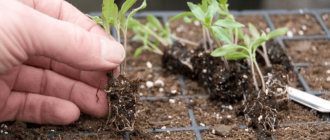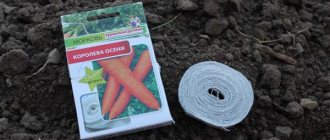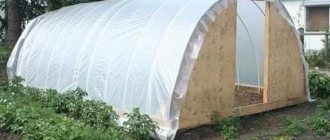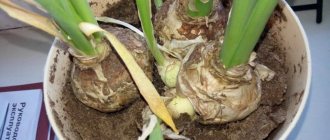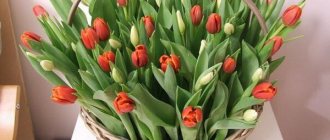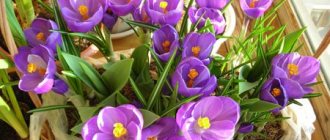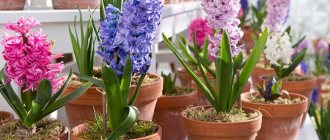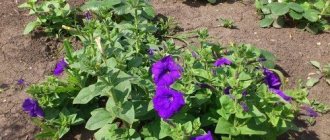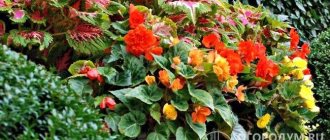Forcing bulbs is not only an exciting, but also a useful activity. If you wish, you can even start your own business selling flowers. But first you need to understand the nuances!
By the end of summer, everything in the daffodil bulbs is ready for spring flowering, in particular, microscopic leaves and buds have been formed. But you can speed up the process and make the plant grow and bloom faster, for example, by the New Year or March 8th. The main thing is to create favorable conditions for development.
So, to start driving daffodils, you will need:
- bulbs;
- containers for planting;
- fresh garden soil or store-bought soil;
- sand, peat or sawdust;
- expanded clay;
- a paper cone or plastic container that can be used to cover the container on top;
- plastic bag.
Further care
When the shoots reach 4-5 cm, you can remove the shelter and move the plants to a warmer place. It should be borne in mind that early varieties develop faster. The paper caps are removed from the pots so that the sprouts receive enough light and do not stretch.
Watering is done through a tray; you can add Epin, diluted according to the instructions. The water should be soft (melt, well, or standing for at least 2 days) and not cold.
Important! Do not allow liquid to accumulate in the pan. This leads to rotting of the corms.
The optimal temperature is 15-18 degrees. Higher temperatures will provoke early flowering of narcissus on weak and fragile peduncles. Because of this, flowering will be weak and short..
At this time of year, plants still do not have enough light, so they will need additional lighting. But it is important that the lamps do not increase the temperature around the flower. Use fluorescent lamps or special phyto lamps with a red-violet spectrum.
Daffodils bloom for no longer than a week. A trick will help prolong flowering - put the flower pots in a cool place at night (basement, glassed-in balcony), where the temperature is no higher than +6 degrees, but not lower than +4.
Advice. If forcing flowers is planned for subsequent cutting, the peduncles are cut at the initial stage of flower opening. If daffodils are given directly in a pot, wait until they are in full bloom.
The daffodil does not require any feeding during forcing. The plant receives all the nutrients it needs for flowering from the bulb.
Variety of varieties
Daffodils are one of the first to bloom after a long winter, bringing brilliant colors and spring well-being to a boring gray-white-black life.
Depending on the plant variety, of which there are currently more than thirty, the leaves may have different lengths and widths, but the color of the leaves is invariably identical - intense dark green.
The flowers are primitive and double in white and yellow. There are also varieties with a two-color crown color. Not long ago, a very beautiful variety of flower with a pink crown appeared. The flowers are located on separate peduncles, so pruning them does not cause any damage to the bulbs.
A feature of the bulbs of this plant is the presence of 2 renewing buds, which are at different stages of formation. The bulbs are covered with a thick chestnut-colored skin and have an elongated shape reminiscent of a pear. The roots grow most intensely in the fall; they live for 10-11 months, after which they die.
There are many varieties of indoor daffodil (Magnet, Fortune and Yellow sun), but the most famous type of this plant is the Paper variety. It has a lot of white flowers located at the same time on one peduncle.
With proper care, home daffodils bloom from December to March inclusive.
Soil and container
In order for the forcing of daffodils to be successful on March 8 or another holiday, you need to choose the right soil and container for the plants. The soil for daffodils can be prepared the same as for tulips. In this case, sand (1 part) and garden soil (2 parts) are used. You can also purchase a special soil mixture consisting of clay, sawdust, minerals and river sand. The soil should be soft, but not sticky.
A pot for growing daffodils should be made of clay or ceramic. Its width should be 10–13 cm, and the height of the sides should be 15 cm. There must be holes at the bottom to remove excess water. You can plant 2–4 bulbs in such a container at home. It is also possible to use wooden boxes.
Comments (4)
Mokina Sveta
03/21/2018 at 09:59 |
Every year my dacha neighbor produces daffodils for the holidays of March 8 and Easter. And he makes a very good income. I tried, but I just can’t figure out the timing.Answer
Yulia Expert Plodogorod
02/24/2020 at 22:48 |
Hello, Sveta! To force daffodils, it is important to choose the right varieties, observe the temperature regime and timely plant the prepared bulbs. But, in addition to the above, there are several more factors that influence the success of the enterprise.
The soil used for planting bulbs should not be acidic. The soil must be neutral or slightly acidic. We recommend checking the indicated indicator when the substrate is ready and adding deoxidizers if necessary.
If daffodils are cultivated in boxes, the planting should not be thickened. The roots should not intertwine, as the plants will compete for water and nutrients, which will negatively affect the speed of development and quality of the buds.
Feeding is important during the cultivation process. But both their shortage and excess or incorrect application can negatively affect the flowers. You can use special formulations for bulbous flowering crops. It is important to avoid overfeeding with nitrogen.
One of the most important factors is lighting. If after germination it is insufficient, the crop will develop more slowly, which will especially noticeably affect the growth of peduncles. Drought also negatively affects the quality of flowers and the speed at which they appear.
Daffodils do not produce buds or these processes are greatly delayed if the crop is sick with botrytis. Therefore, pre-planting fungicide treatment is very important.
Answer
Anna
04/20/2018 at 02:13 |
Narcissus is one of my favorite spring flowers. He is the first to please me with his flowering. I didn’t notice any particular difficulties in growing and caring for them. I haven’t tried to drive them out at a specific time; they grow and bloom on their own around April.
Answer
Yulia Expert Plodogorod
02/24/2020 at 02:01 |
Hello Anna! Daffodils are really easy to grow if the right conditions are created. So, this culture loves sunny areas or diffuse shade. When choosing a location, you need to rely on the characteristics of the variety, because taceta daffodils bloom poorly in shady places, and large hybrids, on the contrary, fade in strong sun.
Bushes get sick less if the bulbs are planted in areas protected from drafts and cold winds. To protect the rhizome from rotting, it is better to plant these flowers in light and well-drained soils, and to ensure abundant flowering, it is better to fertilize the soil and make it fertile.
To ensure that the soil composition is optimal, we recommend adding sand, rotted humus, as well as superphosphates and potassium sulfate before planting the bulbs.
The denser the soil structure, the closer to the surface the bulbs are planted. This must be taken into account when preparing plants for winter. For shallow planting, mulching or covering with agrofibre is required. The optimal depth on clay soils is 7-8 cm, and on light soils about 15.
In the latter case, it is important not to plant the bulbs too close to the surface, otherwise there may be problems with flowering. The buds will fade without even blooming.
Answer
Description
Narcissus is a spring flower: it is one of the first to delight with its beauty after a long, dull winter.
These flowers are great outdoors, but they can also look great in a pot at home. Daffodils grow small, have white and yellow delicate petals and always dark green leaves. Their buds can be either simple in structure or terry: the latter are the most decorative. Varieties with a two-color yellow-white color have already been bred. Recently there has also been a variety that has a pink outer edge. The flowering period is from December to March.
Narcissus is a bulbous plant. Its peculiarity is the presence of two renewal buds on the bulbs: each of these buds is at its own stage of development. The bulbs are covered with a brownish skin on top and are elongated and pear-shaped.
Varieties
Today, the scientific botanical world has more than 30 different varieties of daffodils, most of which are suitable for home cultivation. Below is a short overview of the most popular varieties.
Paper
Probably the most popular variety for indoor cultivation. The flower boasts many snow-white buds located on one straight peduncle.
Magnet
A wonderful yellow daffodil that can bring brightness and liveliness to the most dull interior.
Avalanche
An unusual-looking flower with two-color petals: the center of the bud is yellow, and the edges of the petals are white. Despite its exotic appearance, the variety is unpretentious.
Flower growers also praise the varieties Little Pearl, February Gold and Snowball.
Best conditions
The ideal temperature for flower development is between +16-18 degrees.
Flowering usually lasts from 7 to 10 days, after which the greens are cut off and the bulbs are thrown away. However, some gardeners save them and plant them on the site in the spring. During the coming season, the bulbs will not produce greenery, but in a few years they will grow to the required size for a new forcing. To do this, the bulbs are grown and dug up annually.
Preparing the bulbs
After digging, store bulbs from your own garden in a dry and cool place until autumn (temperature +15..18 degrees). Then, disinfect the bulbs in a solution of potassium permanganate, “Maxim” or “Fitosporin” for 25-30 minutes. Next, without drying, place in the vegetable compartment of the refrigerator for at least 2 weeks.
Planting material is wrapped in a damp cloth or immersed in moistened sawdust.
Varieties of daffodils from the following groups are best suited for forcing:
- Tubular,
- Large-crowned,
- Cyclamenaceae,
- Tatset.
Experienced gardeners recommend paying attention to early and abundantly flowering varieties: Geranium, Golden Harvest, Carlton, Rembrant, Verona, Ice Follies.
For flowering in January-April, planting is carried out in August-October. The bulbs in the bowl are placed close to each other so that they are cramped, leaving only the tops on the surface. Tatset daffodils form several flowers on one peduncle, so when forced there will be a whole bouquet.
